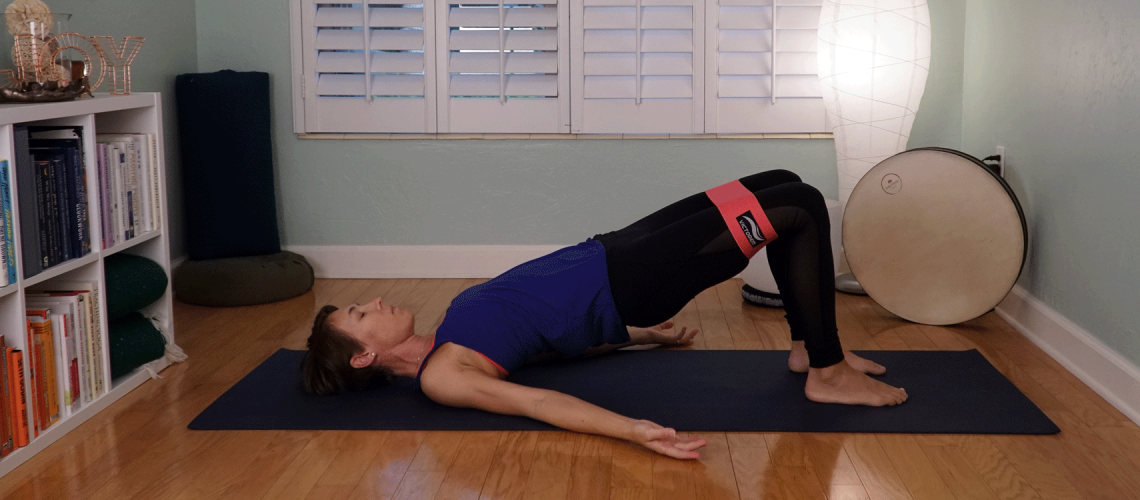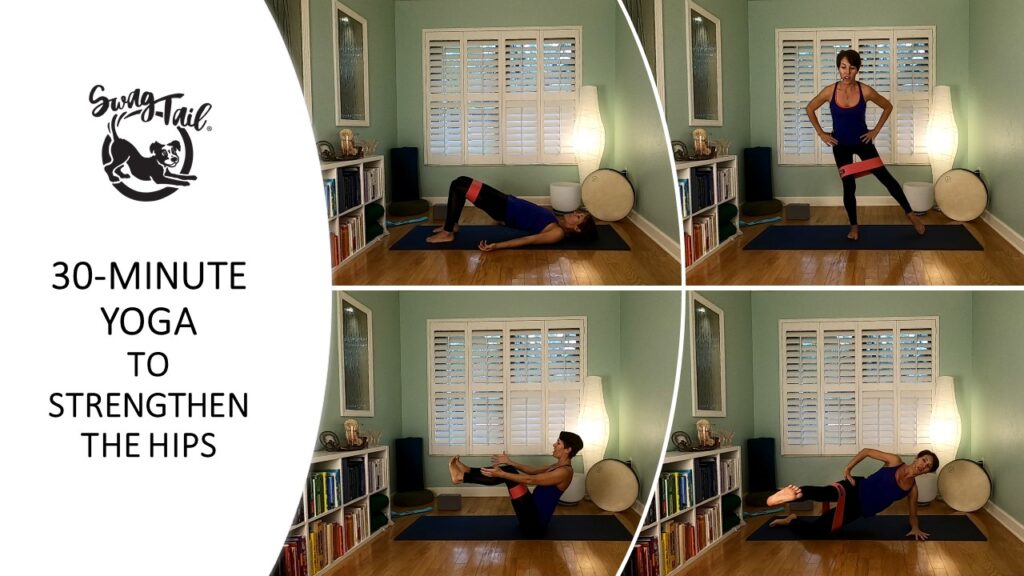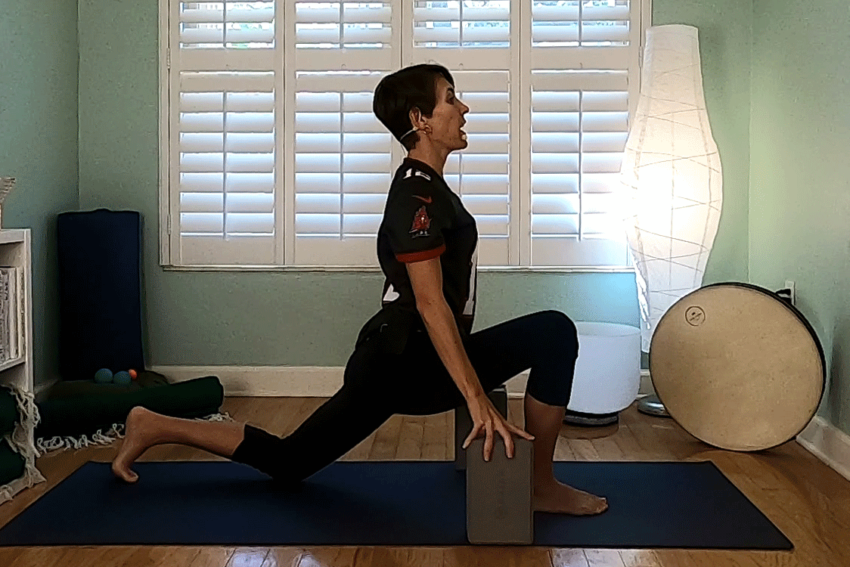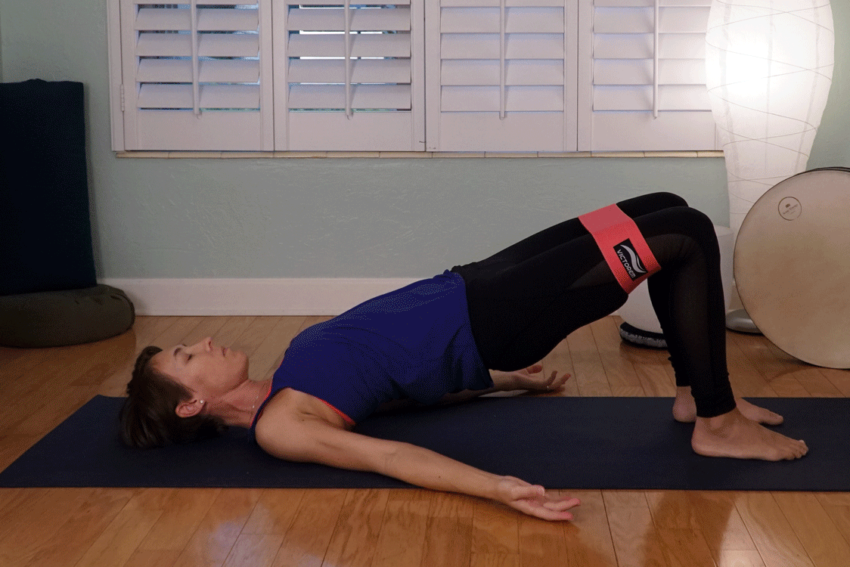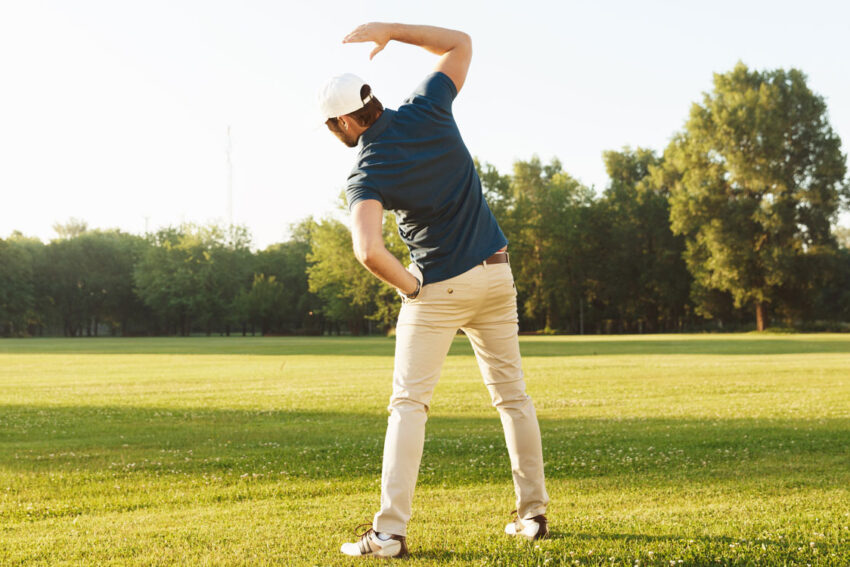Hips play an important role in bearing the weight of your body. They are also responsible for providing a stable base from which to swing your club in golf. Yoga can be used to increase range of motion in the hips. Yet, it’s a practice that can also build strength in that area too. In fact, you can use resistance bands to stabilize the hips and prepare for a more steady, powerful swing now. This blog post shows you how.
For many years of my youth–even through my senior year of high school–I played soccer competitively. This sport requires quick movements and fast reactions to changes on the field. Weight training was my only way to build strength at the time.
Thankfully, my past two decades on the yoga mat have given me insights on how to better balance out the hips.
And, what’s interesting, is that the front hip provides a similar role both on the soccer field and golf course. You use the front hip to plant and derive power from which to kick the ball. As a golfer, the front leg presses down and the hips turn to give you more control and distance with your shots.
Yet one of the many problems I find is that I still sit a lot during the day. I did back then in my school days and I do as a writer now. This creates unwanted weakness in the hips.
You might also find this to be true in your daily life.
That’s why we’ll use resistance bands in yoga to strengthen the hips today. And you’ll discover simple techniques you can use to add just the right amount of flexibility there, too.
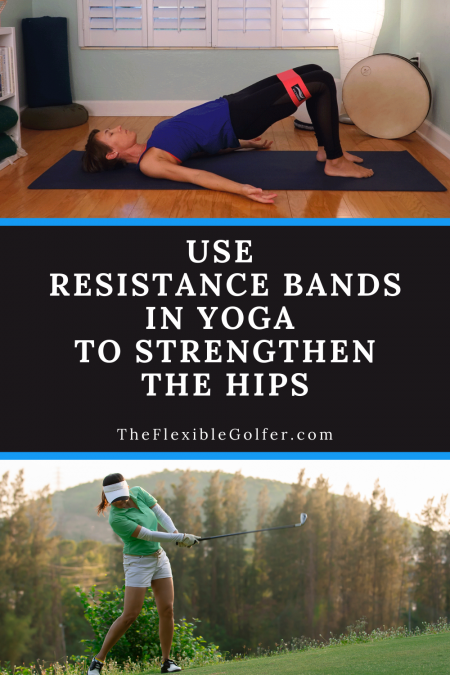
HIPS AND THE GOLF SWING
The hips are a complex area of the body that connects the upper and lower segments of it. They allow us to walk, run, and jump. Since the hips bear most of the body’s weight, they require lots of strength. At the same time, though, the hip joint is also one of our most flexible joints and allows a greater range of motion than all other joints in the body except for the shoulder.
Here’s how the hips affect your golf swing:
In the backswing, your hips are flexed. You tilt the pelvis slightly forward to hinge your torso over the ball. This requires core strength, muscular engagement at the front of the hips and thighs, as well as lengthening at the back of the legs.
To sum it up, you need good balance, strong sensory awareness, and strength in the lower body before you even start your backswing.
In the downswing, your lead foot presses down into the ground. This initiates the ground reactive force and begins to transfer the weight to the target side of your body. Basically, it gives you power.
Then, those very same hip stabilizing muscles come into play to give you even more fuel. Your glutes and external hip rotators start the turn of the hips toward your target. The quadriceps help straighten the knee to push the ground away. And, the hamstrings and glutes extend the hips and pelvis forward.
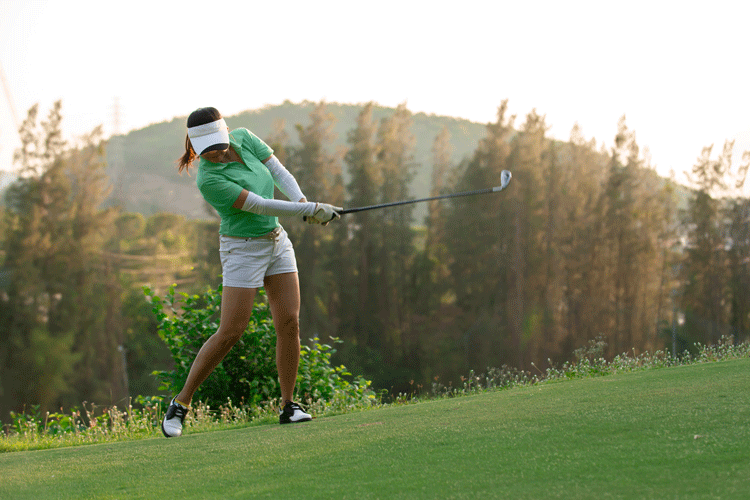
THE PROBLEM WITH WEAK HIPS
Strong hips are not only beneficial for graceful and injury-free movement in life, they are essential to improve your golf game. If your hips stabilizers are weak, your hips will sway side to side during your backswing. This decreases your ability to hit the ball consistently and results in more missed shots during your game. Plus, weak hips can result in less power generated in your downswing. This could affect the coordinated movement of your swing and the distance the ball flies with each shot.
The yoga postures below will help you increase stability in the hip region. They will also increase your balance and proprioception–two other essential golf-ready elements to enhance your game.
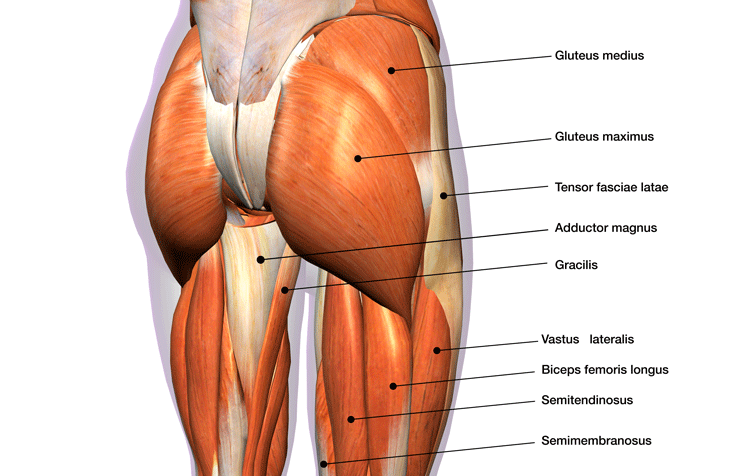
RESISTANCE BANDS IN YOGA
Resistance bands are essentially lightweight, elastic straps used to increase tension during a physical activity. The best part is that they come in a variety of lengths and degrees of tension. This means you can adjust the difficulty of any particular activity to meet your needs.
For example, a lightweight use of resistance bands are often used in physical therapy. This allows individuals to retrain injured areas of the body and return back to their normal state of health (and hopefully an even better one). They are also great for older populations who might be doing simple movements in chair yoga. Plus, active individuals seeking to gain even more strength can up the challenge to meet their own goals as well.
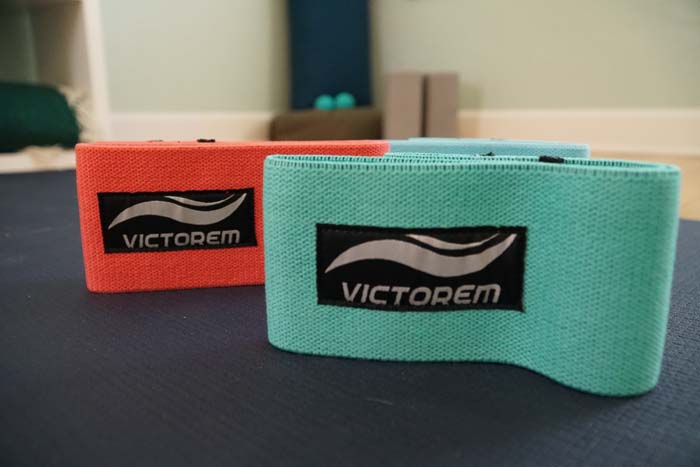
BENEFITS OF RESISTANCE BANDS
While gravity can be a great challenge to fight in yoga, you can add more resistance with resistance bands, too. Here are some other benefits they offer. You can:
- Customize a yoga (or fitness) routine to your needed degree of difficulty, since you control the tension and length of the band
- Build more strength
- Increase body awareness
- Improve muscle memory and greater balance within muscle groups
- Target smaller muscles of the body that get overlooked in other workouts
I CHOOSE VICTOREM RESISTANCE BANDS
Not only do I like high-quality items, I enjoy them to be practical as well. The Victorem resistance bands are just that!
They’re made from a very soft material that allows you to move with ease. They are also thick and colorful and easy to store when you’re done with your practice. Better still, you can store them easily in your golf bag to use in your warm up before a round of golf!
STRENGTHEN THE HIPS IN THIS CLASS
You can view the poses below and start using resistance bands in yoga to strengthen the hips. You can also take this yoga class with me now on our YouTube channel.
Props you’ll need for class:
- A yoga mat
- A Resistance Band. (I prefer Victorem resistance bands)
- One or two blocks
7 WAYS TO USE RESISTANCE BANDS IN YOGA
The following poses are a way you can incorporate resistance bands in yoga to strengthen the hips. I suggest a brief warm up, such as a few rounds of half sun salutations, to bring the entire body to life. Then, when you’re ready, complete the following poses in order.
(1) CHAIR POSE WITH TOE TAPS
Purpose: The goal here is to engage the gluteus group. Yes, maximus, medius, and minimus all turn on when you bend the knees and sit down into your chair pose. Gravity creates a natural resistance in this pose. Yet, when you have the resistance band around the thighs, you add another layer of resistance for glute medius, minimus, and TFL.
Length: Complete 10-15 toe taps each side.
Stand in Tadanasa, or mountain pose, when you’re done.
(2) SUMO SQUAT CIRCLES
Purpose: The squats in this movement are similar to the chair pose above, although might be deeper and more intense in nature. The trick here is to move in circles, first clockwise then counterclockwise. This emphasizes balance while you use resistance bands in yoga here to build strength in the hip abductors.
Length: Take 1-2 circles in each direction (5-6 steps in each circle)
Stand in Tadasana, or mountain pose, when you’re done.
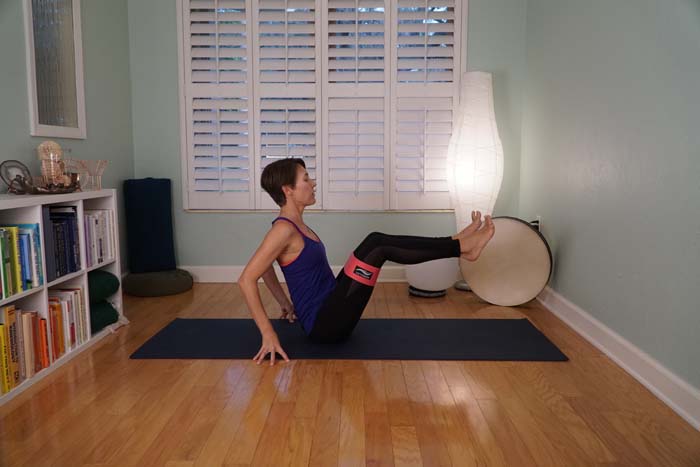
(3) NAVASANA, OR BOAT POSE
Purpose: A powerful golf swing also requires a strong core to protect the spine. This is a symmetrical pose that gives the hips a bit of a break and focuses more on enhancing abdominal endurance. Plus, the band around the thighs reminds you to keep the legs slightly engaged and parallel.
Length: 5-10 cycles of breath
(4) BRIDGE
Purpose: This symmetrical pose elongates the front line of the body while engaging the hamstrings. While you’re not pushing outward against the band, you can use the awareness of it to keep your thighs parallel and active.
To make this more challenging, inhale and take your right knee into your chest (while pushing the left foot into the ground). Then, exhale and reach your right leg to the sky. Inhale, and then drop the back of the pelvis to the ground as you bend the right knee.
Length: Hold bridge pose for 5-10 breaths, or repeat the movements 5-10 times, before returning the back of the hips to the ground. Pause before moving to the second round (or the second side)
(5) SIDE-LYING HIP STRENGTHENER
Purpose: This series of movements employs the resistance of gravity and the band to build more strength. Plus, you increase upper body strength by pressing your forearm into the ground.
Length: 10 -15 rounds each side.
Rest on your back when done with both sides.
(6) TABLE TOP
Purpose: Lifting one leg at a time from the tabletop position builds strength in the hamstrings. This area often gets weak from sitting and creates low back tension. This work can offset these unwanted side effects and restore balance around the hip region again.
Length: 10-15 rounds each side
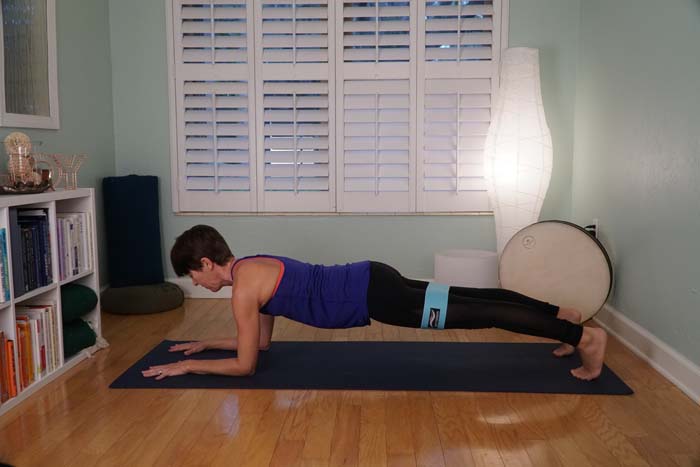
(7) FOREARM PLANK WITH TOE TAPS
Purpose: You’ll finish with a symmetrical pose that engages the entire body–shoulders, core, and legs. Adding the toe taps to the side requires you to keep all of these muscles turned on while you engage the side of the hips again.
Length: 10-15 taps each side. Rest on your back when done.
3 POSES TO STRETCH THE HIPS
Once you have strengthened the hips, it’s time to elongate the tissues in this area. Remember, the goal is to have both powerful and pliable muscles. The three stretches below will help create this balance once again. It will also help return your heart rate and breathing to your natural rhythm.
- Pigeon stretches the external rotators of the hips.
- Supta Padangustasana. This reclined-head-to-toe stretch is a great way to stretch the hamstrings after working them so hard in the active poses above.
- Supported Bridge with a Hip Flexor Stretch. When you place the back of your pelvis on a block, you give the low back a chance to release. Pairing this with holding a knee into your chest, you elongate the hip flexors and quadriceps, too.
Remember to also take a few minutes in Savasana so the entire body can recalibrate to your new training levels.
PUTTING IT TOGETHER
The hips are a complex area of the body that allow you to walk, run, and complete a golf swing over and over again each round you play. This requires lots of strength, and you can use resistance bands in yoga to build this endurance. The end result? More balance around the hips socket. Greater coordination each time you swing as well. And more stability from which to hit the ball with increased power!
Take Action Now:
- Order your own set of Victorem resistance bands now
- Take this class with me now on our YouTube channel.
- Learn more about the different elements of a golf-ready body
- Discover how you can incorporate yoga as a cross-training plan to improve your golf game today.
